-
 bitcoin
bitcoin $123963.239194 USD
1.37% -
 ethereum
ethereum $4529.082464 USD
1.07% -
 xrp
xrp $2.983640 USD
0.71% -
 tether
tether $1.000287 USD
0.02% -
 bnb
bnb $1179.874393 USD
2.99% -
 solana
solana $230.633678 USD
1.55% -
 usd-coin
usd-coin $0.999835 USD
0.03% -
 dogecoin
dogecoin $0.254240 USD
1.34% -
 tron
tron $0.341176 USD
0.15% -
 cardano
cardano $0.842285 USD
0.52% -
 hyperliquid
hyperliquid $48.537896 USD
-0.86% -
 chainlink
chainlink $21.863092 USD
-0.84% -
 ethena-usde
ethena-usde $0.999743 USD
-0.07% -
 sui
sui $3.579561 USD
-0.18% -
 stellar
stellar $0.403418 USD
2.67%
DeFi transaction gas fees are too high? Is there any way to save gas?
High gas fees on Ethereum can deter DeFi users, but strategies like timing transactions during off-peak hours and using Layer 2 solutions can significantly reduce costs.
May 08, 2025 at 11:42 am
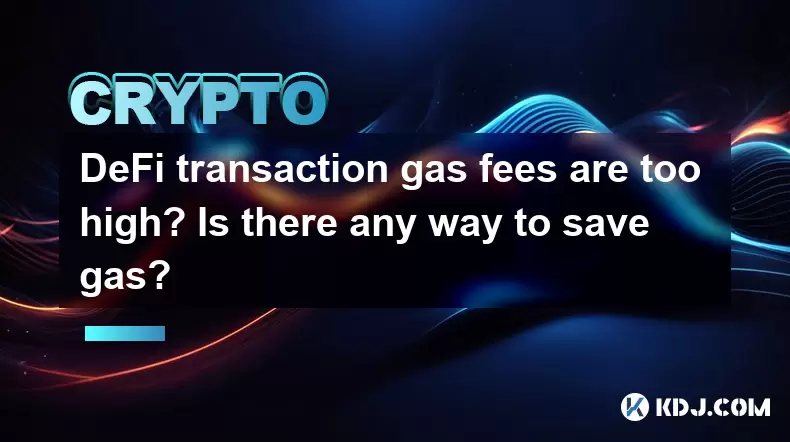
High gas fees in DeFi transactions can be a significant barrier for many users looking to engage with decentralized finance platforms. Gas fees are payments made to miners or validators on a blockchain network for processing and validating transactions. In Ethereum, where most DeFi activities occur, these fees can fluctuate widely based on network congestion and the complexity of the transaction. However, there are several strategies that users can employ to save on gas fees and make their DeFi interactions more cost-effective.
Understanding Gas Fees
Before diving into the methods to save on gas fees, it's crucial to understand what they are and why they can be so high. Gas fees on the Ethereum network are measured in units of gas, where each unit of gas has a price in Ether (ETH). The total fee is calculated as the product of the gas used and the gas price. Transactions that require more computational resources, such as smart contract interactions, will use more gas and, consequently, cost more in fees. During times of high network demand, miners prioritize transactions with higher gas prices, leading to an increase in fees.
Choosing the Right Time for Transactions
One effective way to save on gas fees is to time your transactions during periods of lower network congestion. Ethereum gas prices can vary significantly throughout the day, often peaking during business hours in major time zones. By monitoring gas price trackers like EthGasStation or GasNow, users can identify times when gas prices are lower, typically late at night or early in the morning. Scheduling transactions during these off-peak hours can result in substantial savings.
Optimizing Transaction Settings
Another approach to reducing gas fees is to optimize transaction settings directly within your wallet or DeFi platform. Most Ethereum wallets allow users to set a custom gas price and gas limit for their transactions. Setting a lower gas price can reduce the cost of the transaction, but it may take longer to be processed. It's important to strike a balance between cost and speed. Some wallets, like MetaMask, provide a slider that suggests different gas prices based on current network conditions, making it easier to find the right setting.
Using Layer 2 Solutions
Layer 2 solutions offer another avenue for saving on gas fees. These are protocols built on top of the Ethereum blockchain that can process transactions more efficiently and at a lower cost. Popular Layer 2 solutions include Optimism, Arbitrum, and Polygon (formerly Matic). By moving your DeFi activities to these networks, you can enjoy significantly lower gas fees. To use a Layer 2 solution, you'll need to bridge your assets from Ethereum to the Layer 2 network, conduct your transactions, and then bridge them back to Ethereum if necessary. Here's a basic guide on how to use Polygon:
- Download and set up a compatible wallet like MetaMask.
- Visit the Polygon bridge website and connect your wallet.
- Deposit your ETH or ERC-20 tokens from Ethereum to Polygon.
- Conduct your DeFi transactions on Polygon, enjoying lower gas fees.
- Withdraw your assets back to Ethereum when needed.
Leveraging Gasless Transactions
Some DeFi platforms and wallets are beginning to offer gasless transactions, which allow users to interact with the platform without paying gas fees directly. This is often achieved through meta-transactions, where the platform or a third party covers the gas costs. Examples include platforms like Biconomy and OpenZeppelin's Gas Station Network. To use gasless transactions, you'll need to:
- Sign up for an account on a platform that supports gasless transactions.
- Connect your wallet to the platform.
- Authorize the platform to cover your gas fees.
- Conduct your transactions as usual, without worrying about gas costs.
Utilizing Gas Tokens
Gas tokens are another innovative way to save on gas fees. These tokens allow users to 'purchase' gas at a lower price during off-peak times and use it during peak times. The most well-known gas token is Chi, which can be used to refund a portion of the gas fees spent on transactions. To use Chi gas tokens:
- Acquire Chi tokens from a decentralized exchange.
- Use a compatible wallet like MetaMask that supports Chi.
- Set up your transaction to use Chi for gas refunds.
- Conduct your transaction and receive a partial refund in Chi tokens.
Participating in DeFi Platforms with Lower Fees
Finally, consider participating in DeFi platforms that inherently have lower gas fees. Some newer DeFi protocols are designed to be more gas-efficient, reducing the cost of transactions. For example, platforms like Uniswap V3 and SushiSwap have implemented various optimizations to lower gas costs. Researching and choosing platforms that prioritize gas efficiency can lead to significant savings over time.
Frequently Asked Questions
Q: Can I use gas-saving strategies on other blockchains besides Ethereum?A: While the strategies discussed are primarily focused on Ethereum, some can be adapted for other blockchains. For instance, timing transactions during off-peak hours can be beneficial on any blockchain with fluctuating transaction fees. However, Layer 2 solutions and gas tokens are specific to Ethereum and its ecosystem.
Q: Are there any risks associated with using Layer 2 solutions?A: Yes, there are risks involved with using Layer 2 solutions. These include potential security vulnerabilities, the risk of funds being locked if the Layer 2 network experiences issues, and the complexity of bridging assets back and forth between Layer 1 and Layer 2. It's important to thoroughly research and understand the risks before using these solutions.
Q: How can I track gas prices in real-time?A: There are several tools available for tracking gas prices in real-time. Websites like EthGasStation, GasNow, and Etherscan provide up-to-date information on current gas prices. Additionally, many Ethereum wallets, such as MetaMask, display real-time gas prices and offer suggestions for optimal settings.
Q: Can I save on gas fees by using a different wallet?A: While the wallet itself doesn't directly affect gas fees, some wallets offer better tools for optimizing gas settings. For example, MetaMask provides a user-friendly interface for adjusting gas prices and limits, which can help users save on fees. However, the primary factors affecting gas fees are the network conditions and the complexity of the transaction, not the wallet used.
Disclaimer:info@kdj.com
The information provided is not trading advice. kdj.com does not assume any responsibility for any investments made based on the information provided in this article. Cryptocurrencies are highly volatile and it is highly recommended that you invest with caution after thorough research!
If you believe that the content used on this website infringes your copyright, please contact us immediately (info@kdj.com) and we will delete it promptly.
- BlockDAG, DOGE, HYPE Sponsorship: Crypto Trends Shaping 2025
- 2025-10-01 00:25:13
- Deutsche Börse and Circle: A StableCoin Adoption Powerhouse in Europe
- 2025-10-01 00:25:13
- BlockDAG's Presale Buzz: Is It the Crypto to Watch in October 2025?
- 2025-10-01 00:30:13
- Bitcoin, Crypto, and IQ: When Genius Meets Digital Gold?
- 2025-10-01 00:30:13
- Stablecoins, American Innovation, and Wallet Tokens: The Next Frontier
- 2025-10-01 00:35:12
- NBU, Coins, and Crypto in Ukraine: A New Yorker's Take
- 2025-10-01 00:45:14
Related knowledge

How to track DeFi activity on a block explorer
Sep 04,2025 at 05:36pm
Bitcoin's Role in Decentralized Finance1. Bitcoin remains the cornerstone of the cryptocurrency ecosystem, serving as both a store of value and a benc...
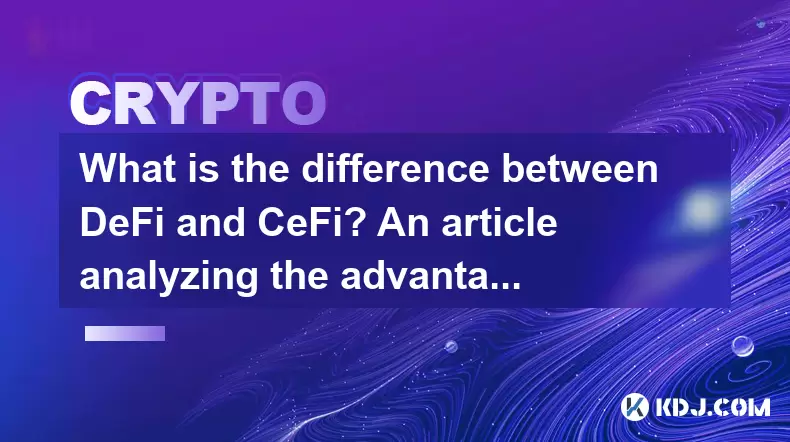
What is the difference between DeFi and CeFi? An article analyzing the advantages and disadvantages of both
Jun 13,2025 at 03:57am
Understanding the Foundations of DeFi and CeFiTo fully grasp the difference between DeFi (Decentralized Finance) and CeFi (Centralized Finance), it’s ...
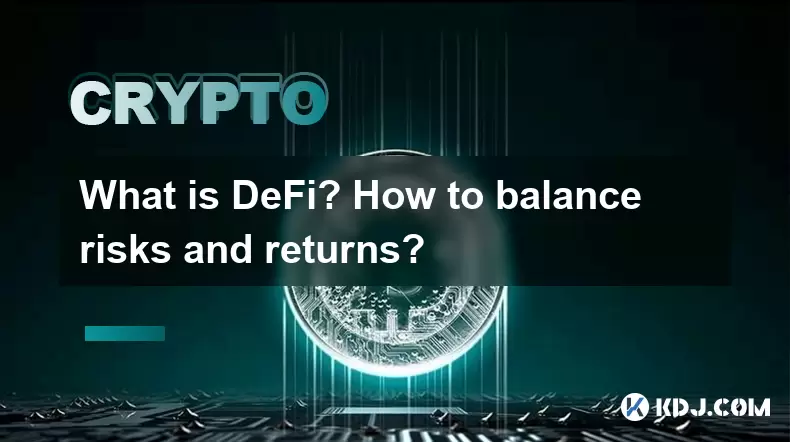
What is DeFi? How to balance risks and returns?
May 31,2025 at 12:22pm
What is DeFi? How to Balance Risks and Returns? Decentralized Finance, commonly known as DeFi, represents a revolutionary shift in the financial ecosy...
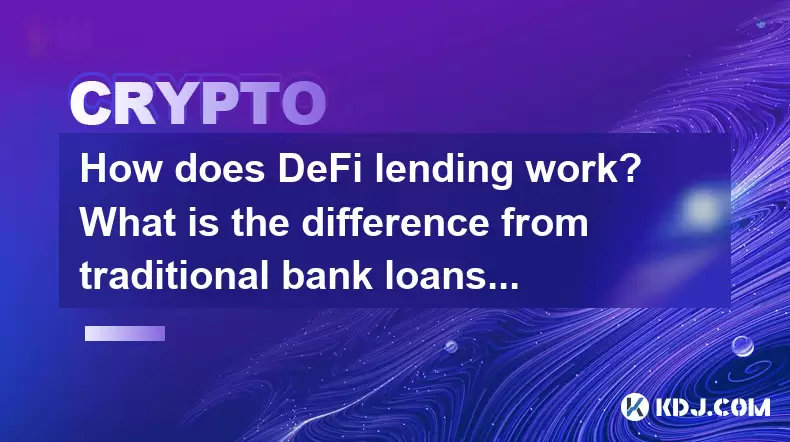
How does DeFi lending work? What is the difference from traditional bank loans?
May 29,2025 at 05:36pm
Introduction to DeFi LendingDeFi lending, or decentralized finance lending, represents a revolutionary shift in the way borrowing and lending are cond...
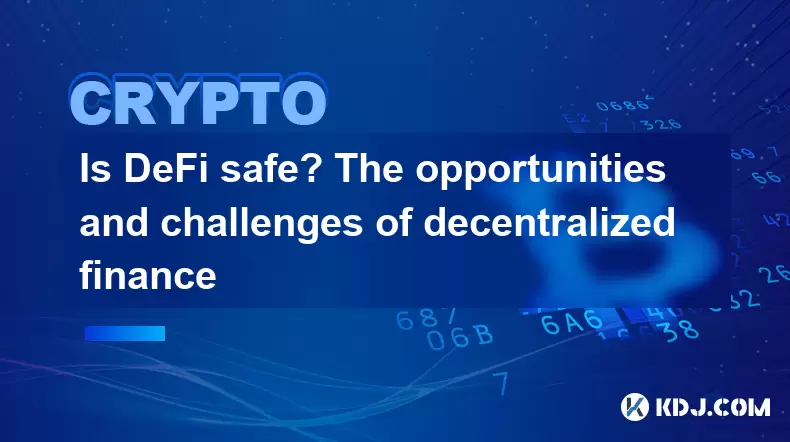
Is DeFi safe? The opportunities and challenges of decentralized finance
May 27,2025 at 02:28pm
Decentralized Finance, commonly known as DeFi, has revolutionized the financial landscape by offering a range of financial services without the need f...
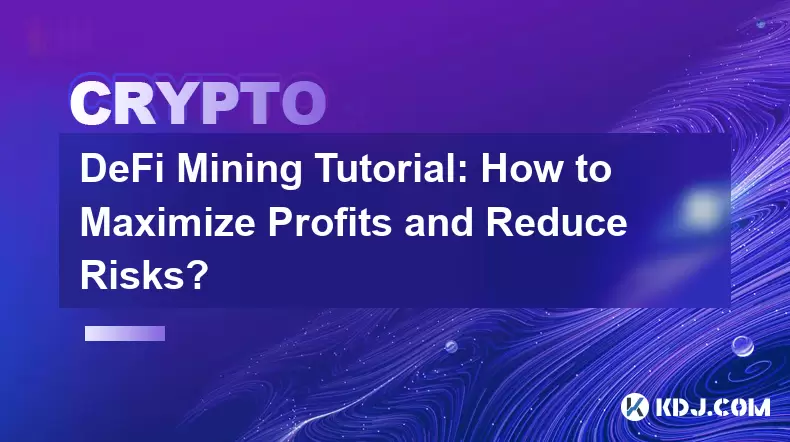
DeFi Mining Tutorial: How to Maximize Profits and Reduce Risks?
May 27,2025 at 07:42am
DeFi, or Decentralized Finance, has opened up a new world of opportunities for crypto enthusiasts looking to maximize their profits through various mi...

How to track DeFi activity on a block explorer
Sep 04,2025 at 05:36pm
Bitcoin's Role in Decentralized Finance1. Bitcoin remains the cornerstone of the cryptocurrency ecosystem, serving as both a store of value and a benc...

What is the difference between DeFi and CeFi? An article analyzing the advantages and disadvantages of both
Jun 13,2025 at 03:57am
Understanding the Foundations of DeFi and CeFiTo fully grasp the difference between DeFi (Decentralized Finance) and CeFi (Centralized Finance), it’s ...

What is DeFi? How to balance risks and returns?
May 31,2025 at 12:22pm
What is DeFi? How to Balance Risks and Returns? Decentralized Finance, commonly known as DeFi, represents a revolutionary shift in the financial ecosy...

How does DeFi lending work? What is the difference from traditional bank loans?
May 29,2025 at 05:36pm
Introduction to DeFi LendingDeFi lending, or decentralized finance lending, represents a revolutionary shift in the way borrowing and lending are cond...

Is DeFi safe? The opportunities and challenges of decentralized finance
May 27,2025 at 02:28pm
Decentralized Finance, commonly known as DeFi, has revolutionized the financial landscape by offering a range of financial services without the need f...

DeFi Mining Tutorial: How to Maximize Profits and Reduce Risks?
May 27,2025 at 07:42am
DeFi, or Decentralized Finance, has opened up a new world of opportunities for crypto enthusiasts looking to maximize their profits through various mi...
See all articles










































































